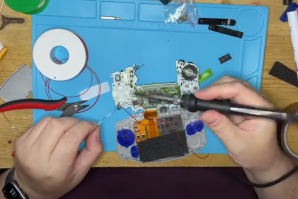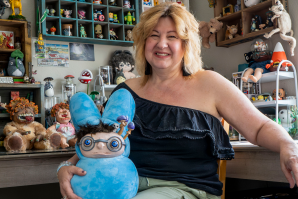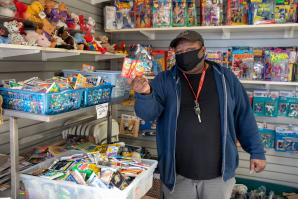Anthony Peluso was laid off last October. He previously managed a sales team at an alcohol distributor. Now the Orangevale resident makes almost as much as he once did with his fallback plan: investing in a children’s trading card game.
Peluso’s love of Pokémon cards was hatched in the ‘90s when Pokémania swept the nation. Over the years, his hobby evolved into a thriving online business. He mainly buys and sells old cards, but said the real money is in brand-new sealed booster packs. He regrets not stocking up on the 2016 sets when he had the chance.
“If I went all in on Pokémon on this date, I’d be rich now and I’m just tired of saying that. So now I’m going all in,” Peluso says. “When it comes to sealed, it’s almost a surefire investment.”
But good luck getting any. Anthony Wescom is the manager of Constellation Collective Sacramento, a hobby shop carrying around 15 different trading card games, known as TCGs for short. The big three are Yu-Gi-Oh!, Magic: The Gathering and Pokémon TCG. The latter has increasingly become difficult to get. The last time the store received its full order from its distributor was in November when the Surging Sparks set was released.
Boxes of Pokémon card booster packs for sale from $100 to $300,
seen May 31 at Constellation Collective Sacramento. (Photo by
Eric Schucht)

Before then, Wescom said he had “mountains and mountains of cases, I couldn’t get rid of them.” Packs sat on the shelves even after being priced below the Manufacturer’s Suggested Retail Price, or MSRP. Ever since Surging Sparks, he’s gotten about an eighth of his orders, which sell out within weeks. He said demand comes and goes in waves. The last spike was around the onset of the pandemic. Now it’s worse. “This is the biggest peak I think it’s ever been,” Wescom says.
Pokémon originated as a Japanese video game series where players catch, train and battle with creatures possessing magical abilities. They can change into more powerful critters after meeting certain conditions. The first games debuted in North America in 1998, followed by trading cards and anime. There were 151 different Pokémon to catch in the first generation. With subsequent games, there are now over a thousand. The series has earned an estimated $147 billion in revenue, according to Visual Capitalist — making Pokémon the highest-grossing media franchise of all time. There’s money to be made in Pokémon even on the local level across the Capital Region, but profits aren’t guaranteed.
Unlike other pop-culture collectables like action figures or comic books, buying new trading cards is a gamble. Each pack is a random assortment, with some cards rarer or more valuable than others. Maybe there’s one in there worth thousands. Maybe not. Holding onto unopened products is always a safer bet, especially since the supply will only diminish over time.
However, these long-term investors are in the minority. Far more popular is scalping. These resellers take advantage of shortages for a quick payday. They’ll swarm big box retailers or stake out vending machines to snatch up booster packs to then list online at a significant markup. Among enthusiasts, a love for Pokémon is equally matched by a hatred for scalpers.
“Unfortunately, there’s a good amount of people buying it at these absurd prices,” Peluso says. He discourages card scalping, but it’s prevalent because it works. “I don’t think that’s a way people should be profiting off of the hobby, but it’s definitely happening.”
But what’s causing this recent surge in demand for Pokémon cards? Drew Radakovitz sells all kinds of merchandise at The Cave, a collectibles shop he co-owns with four locations in the Sacramento area, but calls comic books and trading cards “the poor man’s stock market.” Hopeful investors snatch up collections in hopes of finding a valuable piece that’s mispriced.
Tamarrier Watson points to one of his Jirachi cards on May 31 at
Skyscraper Comics in Sacramento. (Photo by Eric Schucht)

Increasingly, sales of ‘90s pop culture are booming as millennials in their 30s and 40s earn money and long for nostalgia. They’re the ones snatching up Pokémon memorabilia. “That’s what’s driving a lot of the price action,” Radakovitz says.
Some buyers are trying to rebuild their old childhood collections. Paula Erath, a graphic designer from Sacramento, grew up collecting Pokémon cards as a kid. She had an extensive collection, including a valuable Charizard card. Her mother sold most of them without permission and then lied about it. “There’s a reason I don’t talk to her anymore,” Erath says.
Now she collects new cards “for the love of the art” with her husband and 10-year-old son. It’s an intergenerational activity where they gather around the table, divide up packs, rip them open and take joy in pulling sought-after cards. Lately, they’ve become too expensive for her. “I’ve been purposely not looking because I can’t afford to buy them,” Erath says. “If I don’t look, I won’t be tempted.”
CJ Christensen, a college student at UC Davis, started collecting in the summer of 2024 after watching influencers rip open packs on live streams. It looked fun, and the Pokémon fan liked the idea of a hobby doable from home. Christensen goes after cards that are “just the cutest or most relatable.” Their favorites are the tadpole-like Poliwag, the electric mouse Pikachu and the pink shapeshifting Ditto (for the record, this writer’s favorite is the flightless two-headed bird Doduo).
Christensen is a “low-level reseller,” casually selling off the cards they don’t want on eBay and TCGplayer, or trading with others at in-person events. It’s a way to help others expand their collections while earning money to reinvest back into their hobby. Others do the same. But for those who want brand-new cards, the current state of the market is frustrating. Some are calling it quits. “Giving up a hobby, it’s a loss,” Christensen says. “And I hear so many people doing that because of the scalping situation.”
Collectors like Erath and Christensen don’t play the game. They aren’t even fluent in the rules. Unlike other series, the vast majority of Pokémon card buyers don’t play either. But for those who do, the shortage of new cards is affecting them too, says Tamarrier Watson, of Sacramento. He is a local volunteer tournament organizer and an admin of the Sacramento Pokémon Players group on Facebook. Watson said that because so many people are holding onto sealed products, whether they’re scalpers or long-term investors, there’s less single cards hitting the market.
This makes it challenging for players to assemble competitive decks. Only sets from the last few years are legal to use in official tournaments, making new cards a must for league play. “That’s been a big issue,” Watson says. “Even for me, it’s hard to get the necessary cards.”
This results in fewer people playing the game, especially kids. Watson spoke to me in May while running a Saturday tournament at Skyscraper Comics in Sacramento. A year ago, there would have been up to 40 participants. That day, there were only 17. “Overall, I’ve seen less people,” he says. So, how are sellers responding? Well, when supply doesn’t meet demand, people will create the supply. Watson does his best to assemble competitive decks and sells them as an on-ramp into the community.
Peluso, the sales manager turned full-time card seller, buys old vintage cards for cheap and bundles them together into a homemade booster pack. He said they’re “selling like hot cakes right now.” Sometimes he’ll throw in a few unopened packs to create a Pokémon TCG Mystery Pack.”
It’s a surprise which cards customers will get. Mystery is the appeal. “It’s nostalgic to open the old cards,” Peluso says. “It’s nice, especially with how hard it is with scalpers getting involved and not letting basically anyone get some of the newer sets, people are falling back on that as a way to still get that feel.”
Wescom at Constellation Collective started stocking up on Japanese cards. It’s the same art as the English versions, and they still sell out. The strategy worked. “Then everybody else started doing that,” he says. Plus tariffs made products from Japan less economically viable. Until the market stabilizes, he’s had to limit the number of Pokémon products his customers can purchase daily from him. “You have to limit whether it’s scalping or not. When I get product, I get so little of it, I want it to go to as many people as possible,” Wescom says.
Alexander King poses with the trading card game he created called
Seize: Guilded Treasures. (Photo courtesy of Alexander King)

With the shortage of Pokémon cards, some see an opportunity to launch a competitor. Alexander King, of Roseville, wasn’t happy with the direction mainstream TCGs were heading. Too little player interaction. Too many stale mechanics. Too few chances to come back from an opponent’s runaway lead. “You’re basically playing a game of solitaire with one another, and so whoever’s got a better solitaire setup is going to win unless they miss play,” King says.
Ever the complainer, he finally decided to do something about it. He spent about five years designing Seize: Guilded Treasures, and in May, the game hit hobby store shelves around Sacramento. It’s a trading card game with a movement grid system like chess. “You can do what you will with your money, but we’re here to make a game that’s extremely fun, that is available to you, that you won’t struggle having to find,” King says.
Chris Rodriguez, of Rancho Cordova, is another member of the business, Kings’ Games. He’s a former semi-professional Pokémon TCG player whose claim to fame is selling a one-of-a-kind misprinted card. The sale helped pay for his car. “I’ve had a very long career in Pokémon,” Rodriguez says. But he left the game because he was unhappy with the market.
He felt that few distributors were making it difficult and expensive for shops to get products. That’s why Kings’ Games cut out the middleman and sold directly to small retailers from the Bay Area to Reno. The goal is to take players back to a time before Pokémon cards were scarce.
“It’s a surreal feeling when you and your friend develop a card game and it doesn’t suck” Rodriguez says. “It’s a great feeling watching it grow and people actually having a good time and getting back to the roots of it. It’s not just about the financial investment. It’s about enjoying the gameplay.”
–
Subscribe to the Comstock’s newsletter today.
Recommended For You

Inside California’s Retro Video Game Modding Scene
Modchips and fan games can cross legal lines—but for some, it's a passion worth the risk
Selling modified video games and consoles is illegal but typically unenforced. The fear of a lawsuit from a big tech company is enough to scare away established retailers. A few side-hustlers in the Capital Region take that chance and operate in a gray market.

Crafting in a Crowded Market
Crafting surged during the pandemic. But can Sacramento’s maker community find buyers?
The number of craft sellers on Etsy.com tripled after 2020. We checked in with the veterans and the newbies in the Capital Region’s crafting scene.

Photos: Not Just a Hobby
Amid a surge in card collecting, a few shops still survive in the Capital Region
Card shops have been declining in number the past 20 years, but
there’s a gold rush in the industry today.

Mini Moguls
More youth are reaping the rewards and lessons of entrepreneurship
While browsing in a shop in 2009, 6-year-old Allison Prestwich saw a candle made by the Tyler Candle Co., and she wondered aloud if it was named after her younger brother.



